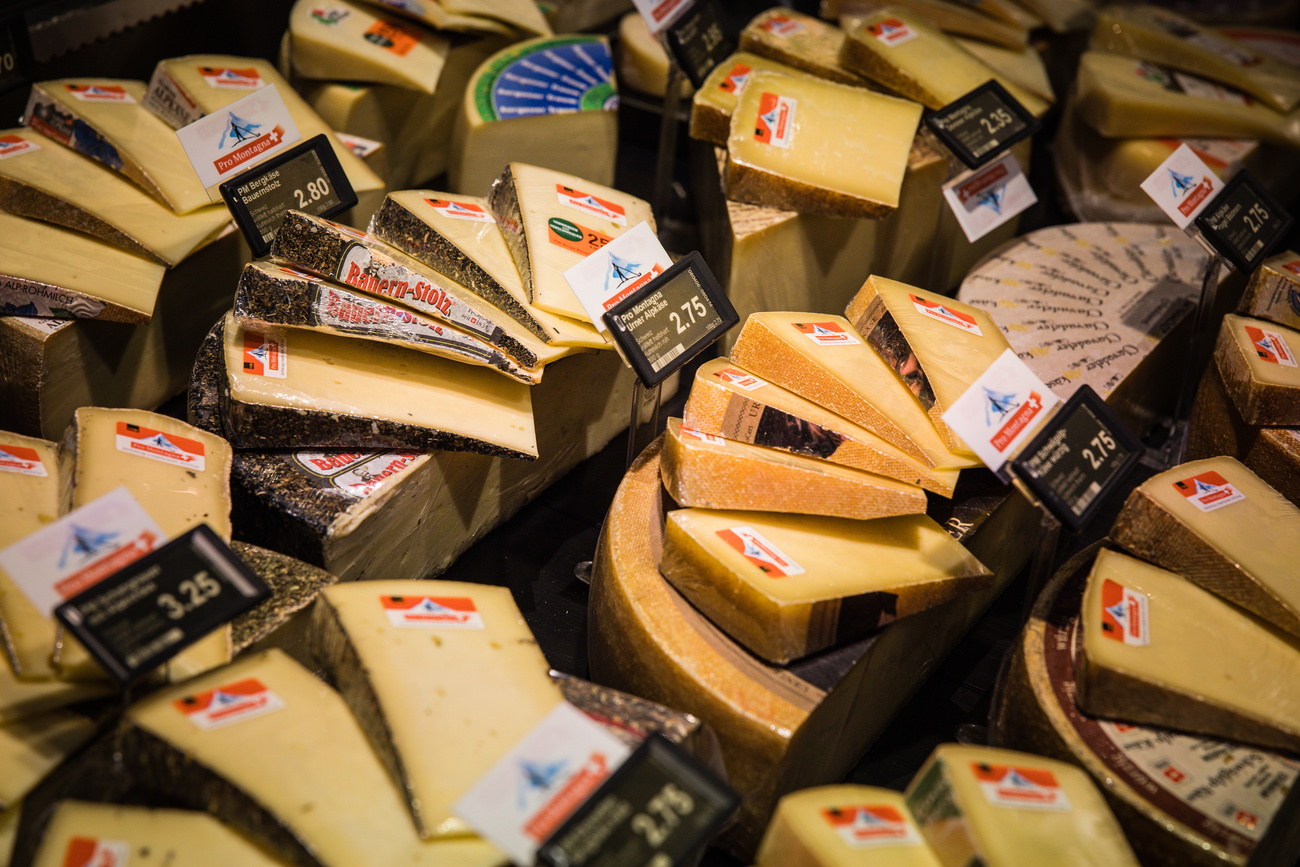
Has food label Nutri-Score passed its expiry date in Switzerland?

Five years on from its adoption, the nutrition labelling system has seen its popularity wane and finds itself in the crosshairs of legislators and the Swiss cheese lobby.
In May, Switzerland’s largest dairy processor, Emmi, and the second-biggest supermarket chain, Migros, announced they were ditching the Nutri-Score label that rates packaged food products for their nutritional value and compares them with similar goods.
Their decisions, made for different reasons, have raised concerns at Switzerland’s food safety watchdog but add to the growing disillusion with the five-colour traffic light-style labelling system, which is intended to allow consumers to compare the overall nutritional value of food products from the same group and from different manufacturers.
Lucerne-based Emmi, whose dairy products include milk drinks, lattés, cheeses, and yoghurts, started trialing Nutri-Score on its best-selling Caffè Latte product in Switzerland in 2021 with a view to rolling it out across its product lines. But the company has now decided to drop the label completely.
The system has no real benefit for its consumers, according to Emmi spokeswoman Simone Burgener.
“Other suppliers and competitors of coffee milk-based mixed drinks have not introduced Nutri-Score on their packaging, so comparability is not possible,” she told SWI swissinfo.ch by email. “In addition, the application has not been harmonised across all European countries in which Emmi operates.”
Migros, which has close to 1,200 stores across Switzerland, had been using Nutri-Score on all its own-brand food since 2021, and questioned the return on its investment.
“Our decision is based solely on our experience over the last three years,” Migros spokeswoman Estelle Hain said. “Since its introduction three years ago, this has shown that the benefits are too small in relation to the high costs and effort involved.”
The exit of the two heavyweights is being seen as a setback by the Federal Food Safety and Veterinary Office (FSVO).
“The Nutri-Score helps consumers to compare similar products,” spokeswoman Tiziana Boebner-Lombardo told SWI swissinfo.ch by email. “The more foods there are to compare, the greater the usefulness of the label. If large product ranges disappear, it will be to the detriment of consumers.”
Early success
Nutri-Score was developed in France and first introduced there in 2017. Food products are rated on a five-level colour-coded scale from a dark green A (most balanced) to a dark red E (most unbalanced). The calorie content and proportion of antinutrients such as sugar, salt, and saturated fatty acids have a negative effect on the rating, while fibre, protein, or the presence of fruit, vegetables, nuts, legumes, and certain oils have a positive effect. A label displaying the ranking is stuck onto the front of packaged food products.
The system has been adopted in Switzerland, Belgium, Germany, Luxembourg, the Netherlands, Spain and, most recently, Portugal this April. It was also in the running to be selected as a pan-European food label that the European Commission proposed in 2020 to harmonise mandatory front-of-pack nutrition labeling as part of its “Farm to Fork” biodiversity strategy under the European Green Deal. However, to date no proposal for such a system has been tabled by the commission.
Switzerland first adopted Nutri-Score in 2019 and close to a hundred producers and retailers covering 229 brands and more than 9,800 products have committed to introducing it.

Cheesed off
But the labelling system has come in for criticism, including from the Swiss cheese industry, which claims that traditional, artisanal Swiss cheeses, especially mature cheese, generally receive the lowest ratings. The poor grades are a result of the cheeses’ high fat and salt content, high number of calories and low fibre.
“In our opinion, Nutri-Score leads to more confusion among consumers than it is a useful tool for a healthy diet,” said Désirée Stocker, spokeswoman for Switzerland Cheese Marketing. “Nutri-Score only rates products within a product category. In practice, this can lead to a highly processed food being given an A, but a natural product such as a semi-hard cheese only a D.”
Skepticism about the system’s value is also prevalent in Italy on similar grounds, with staples like extra-virgin olive oil scoring poorly. Other European nations, including Portugal and Romania, have recently pushed back against Nutri-Score claiming that it does not align with national guidelines on what constitutes healthy food.
The debate has even reached Switzerland’s corridors of power. In March, the House of Representatives approved a motion from the Senate asking the government to define the use of Nutri-Score in more detail in the Food Act.
The Act currently only states that the government may stipulate “special labelling” such as on nutrition value that goes beyond mandatory labelling requirements on origin, designation and ingredients. The Senate’s motion says the assessment of nutrition value is too simplistic and does not take sufficient account of the extent of processing, the presence of additives, or sustainability.
Algorithm decides
The Nutri-Score system uses an algorithm adapted from a concept developed by the UK Food Standards Agency to regulate the marketing of food to children. The algorithm calculates a food’s rating using a three-step process based on its nutritional content. The first version was used in the system introduced in France in 2017 and it was subsequently updated in July 2022 for food and in March 2023 for beverages to incorporate the latest scientific research.
The Swiss government cannot modify the Nutri-Score algorithm unilaterally. It can only offer recommendations when the algorithm is updated through the steering committee of the transnational governance of Nutri-Score (which includes representatives of public health authorities from Switzerland and the six other participating countries). The new algorithm went into force in Switzerland in January and Swiss companies have two years to update their packaging to reflect the changes made.
For Migros, adapting its product labels to reflect the new algorithm was one of the reasons for abandoning Nutri-Score.
“The effort involved is very high: integrating or adapting the Nutri-Score involves a great deal of packaging work. The costs for the phase-out are significantly lower than the further changeover and any future adjustments to all products,” said Hain.
Not perfect but effective
Despite the criticisms of Nutri-Score, some major food companies still support it, including Swiss multinational Nestlé.
“Nestlé was one of the first companies in Europe to introduce the Nutri-Score in 2019,” a Nestle spokesperson told SWI swissinfo.ch. “Since then, we have extended Nutri-Score to our entire product range in Switzerland. We have always been open to an evolution of Nutri-Score that is evidence-based according to the latest science and nutrition knowledge.”
The FSVO says the labelling system remains an important tool for consumers to make healthier food choices. A joint study External linkwith the University Hospitals of Geneva published in 2020 compared it with four other front-of-packaging labels in terms of how it affected the purchasing decisions of more than 1,000 Swiss consumers. It found that the Nutri-Score label “demonstrated the highest percentage of improvement in food choices and the highest overall performance in helping consumers rank the products according to their nutritional quality.”
Nutri-Score is not just influencing consumer choices. A study published this year in the European Review of Agricultural EconomicsExternal link suggests that companies have adjusted their product range to obtain higher Nutri-Score ratings. Products launched or modified after the introduction of Nutri-Score in France in 2017 earned better ratings, indicating a shift to towards healthier packaged food.
Edited by Nerys Avery

More
Subscribe to our weekly top stories

In compliance with the JTI standards
More: SWI swissinfo.ch certified by the Journalism Trust Initiative




























You can find an overview of ongoing debates with our journalists here . Please join us!
If you want to start a conversation about a topic raised in this article or want to report factual errors, email us at english@swissinfo.ch.